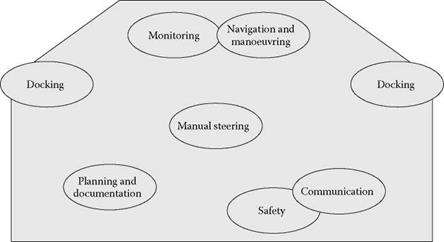A number of basic functions describe the work on a ship’s bridge. A function can be a group of tasks, duties, and responsibilities necessary for the operation of the ship and carried out on the bridge. The most basic functions which have to be taken into account when designing this workplace are (IMO, 2000):
• Navigating and manoeuvring
• Monitoring
• Manual steering
• Docking/undocking
• Planning and documentation
• Safety
• Communication
General guidelines exist for the layout of bridges. These apply both to larger ships, which often nowadays use a so-called cockpit bridge, and to smaller ships which use a more traditional layout. The workstations for navigating and manoeuvring, monitoring, and for the bridge wings should be planned, designed, and placed within an area spacious enough for not fewer than two operators but close enough for the workstations to be operated by one person. As the name suggests, a cockpit bridge is based on the cockpit of an aeroplane. All functions and controls needed by
|
FIGURE 9.4 Bridge layout with suggested work stations and their functions. (Adapted from IMO, 2000. With permission.) |
a single operator or a team of operators are placed centrally and gathered around the operators. An example is shown in Figure 9.4.
Here, the functions listed above are used to describe the workstations. More details of what to include and where to the instruments and controls are found in IMO, ISO, and IACS documents. The specific design and placement of individual instruments and controls will always depend on ship-specific factors such as trade, ship size, and crew size, and will not be discussed here in detail. A brief explanation of the functions (IMO, 2000) follows.




